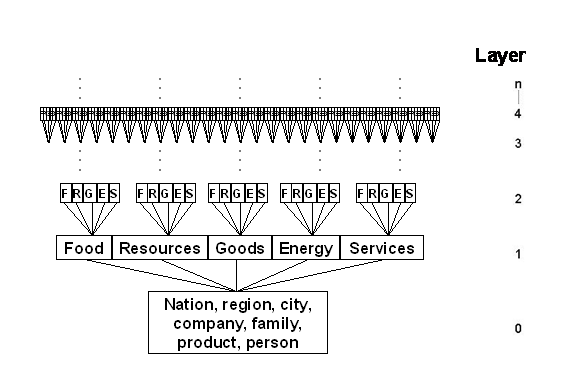|
|
The boundary problem
The need for capturing impacts across the entire upstream and
downstream supply chain (the boundary problem) is of particular
importance and has therefore been noted in the Guidelines of the Global
Reporting Initiative (GRI) and Environment Australia, as well as by the
World Business Council on Sustainable Development and the Green
Environmental Management Initiative.
The Sydney University / CSIRO team can address this boundary problem by taking a
TBL Reporting approach that uses the structure of the Australian
economic system as described in the national input-output tables. This
structure is best depicted as an ever-expanding "tree of interdependence"
that starts at a particular economic entity, and stretches across
upstream production layers, containing sectors at different production
stages linked together by supply chains (see figure). Thus a particular
TBL impact associated with a good or a service cascades from primary
industries producing raw materials, via secondary (manufacturing)
industries into the sector or company that delivers the final product
to the consumer.

By taking into account TBL impacts throughout the entire upstream
supply chains of companies, the quantitative approach developed by the
Sydney University / CSIRO team avoids inconsistencies and loopholes, for example in
the following cases:
- Demerging and outsourcing:
Assume an Australian dairy company "A" that owns the entire production
chain, i.e. production of raw milk at the farm, transport logistics
from farm to factory and the manufacturing site. This company has
significant water usage (mainly at the farm). Assume that the same
company A demerges into two companies �A1� and �A�, or outsources to a company �A1�, with A1
consisting of the farm and transport logistics, while the "new A" is
responsible only for dairy manufacturing. In a conventional (on-site
only, no upstream impacts) TBL reporting regime, A can improve its TBL
(water) performance artificially but significantly, despite the fact
that the supply chain and hence the impact of the product processed
milk is exactly the same.
- Vertical integration: Assume two water suppliers "B" and "B1", where both B and B1 provide water supply and sewage services, but in addition "B1" owns and manages a catchment. In an on-site-only TBL framework, comparisons between these two water suppliers are not valid because - even though they supply the same product - they exhibit different degrees of vertical integration and a different business structure. In this case B1's impact is likely to be higher than B's only because of the additional catchment management activities. In order to provide a fair comparison, the upstream supply chain of B must be taken into account.
- Green supply chain: An Australian manufacturing company "C"
uses large quantities of packaging materials for their product. The
packaging material consists of HDPE and aluminium. Both materials are
energy-, greenhouse-gas- and water-intensive. The management of the
company decides to replace the packaging material with
starch-strengthened biodegradable plastic that is less energy,
greenhouse- and water intense. Under conventional (on-site-only) TBL
reporting C is not rewarded for this shift to a more sustainable
packaging. However, by incorporating supply chain effects the improved
environment performance can be quantified.
- Risk and liability: A manager of an Australian ethical fund
assesses the risk that is posed to a construction company "D" and a water
supplier "E" when faced with a carbon tax. The manager decides to
incorporate E into the ethical portfolio, because D's carbon emissions
from on-site construction machinery are lower than Ds emissions from
water treatment processes. However, D may face much higher additional,
indirect risks than E, which arise out of price increases of
carbon-intensive inputs such as aluminium frames and cement. These
risks are ignored in current TBL approaches.
For further information please contact
|
Dr Arne Geschke
ISA, School of Physics A28
The University of Sydney NSW 2006
+61 (0)2 9036-7505
[email protected]
|
|


